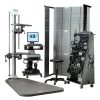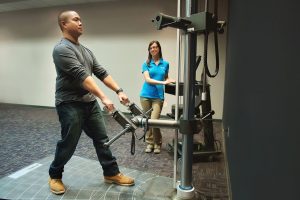
Ergonomics for Injury Prevention for Remote Workers, Manual Labor, and Leisure
Treatment GuidelinesErgonomic evaluation and consulting are done within the workplace. In order to understand the basics of good body mechanics, practitioners must also be aware of the risks associated with improper ergonomics.
Ergonomics is more important now than ever. With so many people working (and generally spending more time) at home, aches and pains are at an all-time high. The best way to help clients prevent activity-related injuries is to teach them about good body mechanics.
Clients may think that a few hours here and there couldn’t possibly hurt them. While that may be the case for some, humans are creatures of habit. So bad habits can become a consistent part of an individual’s routine, which stands to place them at an even greater risk for injury.
Ergonomic evaluation and consulting are done within the workplace, wherever that may be for the individual. In order to understand the basics of good body mechanics, practitioners must also be aware of the risks associated with improper ergonomics.
Ergonomics for Computer Workstations
Individuals who use computers and similarly desk-oriented workstations are at the highest risk for injury. Sitting in front of a screen for extended periods of time, engaging in repetitive motions such as typing and mouse use, and slouched posture are some of the leading causes of injury in a traditional office space.
Individuals with an improper workspace setup are at risk for Carpal tunnel syndrome (CTS), tendonitis of the wrist, elbow, or shoulder, chronic lower back pain, vision changes, migraines, arthritis of the fingers and wrist, lumbar disk injuries, and more. Let’s go over the basics of preventing injuries at computer workstations.
Desk and Chair Height
For proper desk and chair use, an individual’s hips, knees, and feet should be at 90-degree angles. If a client is too short for their feet to touch the floor, even with an adjustable chair, they can use a footrest or a box to keep their ankles resting at 90 degrees. Armrests can also help clients keep their elbows at 90 degrees at their side.
Their chair should give appropriate back support while they are sitting tall. However, if someone has a chair with a lot of adjustability but not as much back support, they can roll up a sweatshirt or towel to place at the small of their back.
Monitor Height
Clients should position the screen at eye-level so the top one-third is visible. They should be able to assume this view while their head and neck are relaxed, shoulders are rolled back, and their spine is straight and tall. If they cannot achieve this position by adjusting the height, they can place books or small boxes underneath the monitor base.
Mouse and Keyboard Placement
Clients should be able to reach both while keeping their wrists flat on your desk, forearms parallel to the floor, and elbows at 90 degrees by their side. The keyboard should function well and not require excessive force to press keys. The wrists should have support, which can come from a cushion below the keyboard and below the mousepad. If a client is unable to get gel cushions for these areas, they can use a rolled-up washcloth instead.
Other Considerations for Desk Ergonomics
Desk workers should keep most items they need within arm’s reach to prevent straining or assuming awkward positions. Ideally, those sitting at computers should get up to stretch and move around for 10 minutes every hour. This not only gives the eyes and body a break from redundancy, but it also helps improve circulation.
Ergonomics for Manual Laborers
Another population that is at risk of injury at work is those who work in physically demanding jobs. Plumbers, electricians, movers, factory workers, and hospital workers such as aides and therapists should be informed of safe lifting techniques. These people are especially at risk of herniated discs, spinal fractures, muscle sprains (to the upper and lower bodies), chronic lower back pain, falling, and more.
Those who transport large, heavy objects should use following guidelines to prevent injury in the workplace:
- Use machinery such as forklifts, hand trucks, and pallet jacks whenever possible
- Take advantage of ramps
- Obtain suctions to create temporary handles
- Recruit the help of others to help you move a large object or person
- Prevent the need to bend when lifting items by keeping materials on shelves at eye- or chest-level
- Never twist your body when lifting
- Take breaks throughout the day whenever you are lifting for long periods of time
- When you must lift objects or people, use the right form
- Spread your feet apart with one foot slightly in front
- Lift with your legs and not your back or waist
- Hold the weight as close to the body as possible
- Keep your head up with your chin tucked
Objective Evaluation for Manual Labor Ergonomics
Working with manual laborers or employer services of any kind, you’ll likely perform Post Offer Employment Testing (POET), Functional Capacity Evaluations (FCE), or return-to-work assessments. Anyone administering these evaluations will tell you how important it is to measure performance objectively with reproducible tests. With the EvalTech by BTE, you get the highest standard of objectivity with zero-guesswork data reports.
The EvalTech is the best-in-class solution for evaluating virtually any job task and even training proper mechanics. Employers rely on the objective, no guesswork evaluation reports to make safe decisions for their employees. If your clinic currently offers employer services, or you want to start a new program, learn how the EvalTech can help you provide better evaluations, more efficiently.
Ergonomics for Leisure Activities
Good body mechanics are equally important for recreational pursuits. Hobbies like gardening and sewing can cause people injuries such as CMC arthritis, De quervain’s, tendonitis, cubital tunnel syndrome, bursitis, and neck pain.
Occupational Therapists should be sure to educate clients on the use of good body mechanics to prevent injury. Gardeners should use knee pads or cushions whenever stooping to the ground. They should also use tools with soft, contoured grips in lieu of those with uncomfortable plastic handles.
Those engaging in any hobby that requires repetitive movements should take stretch breaks often. Movements like scooping, threading, digging, and holding a writing utensil can become repetitive. Neck rolls, wrist rolls, and wiggling the fingers every 30 minutes helps improve blood flow and loosen stiff muscles.
Continuing Education for Ergonomics
Ergonomics is important for a range of activities, both work and recreation. Occupational Therapists, Physical Therapists, Chiropractors and a range of other professionals can benefit from obtaining a CEAS if they work in ergonomics. A Level One Certified Ergonomics Assessment Specialist training consists of eleven modules and two assessments that test the specialist’s knowledge in doing ergonomic assessments.
Professionals who wish to pursue more advanced certification can proceed to get a Level Two CEAS credential or a CETS for employment testing and jobsite analysis. Each of these certifications gives professionals the ability to help clients tailor work set-ups to their needs with equipment, stretches, modifications, and posture changes. These credentials enable healthcare professionals to be even more effective in providing assessment and recommendations for injury prevention.
Brittany Ferri, PhD, OTR/L, CPRP is an Occupational Therapist and owner of Simplicity of Health where she provides health writing, consulting, and program development services. She is passionate about client-centered care and the intersection of technology and health. To learn more, visit www.simplicityofhealth.com






